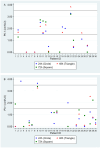Respiratory Drive and Survival in Comatose Out-of-Hospital Post-Cardiac Arrest Patients
- PMID: 40860239
- PMCID: PMC12377396
- DOI: 10.2147/OAEM.S511715
Respiratory Drive and Survival in Comatose Out-of-Hospital Post-Cardiac Arrest Patients
Abstract
Purpose: This study aimed to explore alterations in respiratory drive in comatose patients after out-of-hospital cardiac arrest (OHCA) and their association with survival outcomes.
Patients and methods: A prospective cohort study was conducted on comatose patients with OHCA who were admitted between October 2022 and October 2024. Patients were followed until their discharge from the hospital and subsequently categorized into survivors and non-survivors. Respiratory drive was evaluated using P0.1, representing the airway occlusion pressure measured within the first 100 ms of inspiration, as displayed on the ventilator. Measurements were collected together with additional parameters at 24, 48, and 72 h following admission.
Results: The analysis involved 30 patients, with an in-hospital mortality rate of 53.3%. Over the 72-h observation period, P0.1 values were greater in survivors than in non-survivors; however, this difference was not statistically significant. During the first 24 h, survivors demonstrated significantly lower tidal volumes per predicted body weight (P = 0.034). P0.1 values ranging from 1.5 to 3.5 cmH2O in the initial 24 h were independently associated with reduced in-hospital mortality (adjusted OR 0.043, 95% CI 0.003-0.588, P = 0.018).
Conclusion: A trend toward elevated P0.1 levels in survivors was observed. P0.1 values within the range of 1.5-3.5 cmH2O during the first 24 h were linked to a lower mortality rate. These results indicate that P0.1 could be utilized as a prognostic indicator for comatose patients following OHCA.
Keywords: airway occlusion pressure; post-arrest; respiratory drive; survival; ventilation.
Plain language summary
This study explored how changes in respiratory drive relate to survival in unconscious patients after a cardiac arrest outside the hospital. Respiratory drive was assessed using P0.1, which measures the effort to take a breath, at 24, 48, and 72 hours after admission. The results showed that survivors tended to have higher P0.1 levels than non-survivors. Notably, patients with P0.1 values between 1.5 and 3.5 cmH2O in the first 24 hours were more likely to survive. These findings suggest that P0.1 could be a useful tool for predicting outcomes in critically ill patients.
© 2025 Sintrirat and Vattanavanit.
Conflict of interest statement
The authors declare that they have no competing interests in this work.
Figures
Similar articles
-
Prescription of Controlled Substances: Benefits and Risks.2025 Jul 6. In: StatPearls [Internet]. Treasure Island (FL): StatPearls Publishing; 2025 Jan–. 2025 Jul 6. In: StatPearls [Internet]. Treasure Island (FL): StatPearls Publishing; 2025 Jan–. PMID: 30726003 Free Books & Documents.
-
[Volume and health outcomes: evidence from systematic reviews and from evaluation of Italian hospital data].Epidemiol Prev. 2013 Mar-Jun;37(2-3 Suppl 2):1-100. Epidemiol Prev. 2013. PMID: 23851286 Italian.
-
Intravenous magnesium sulphate and sotalol for prevention of atrial fibrillation after coronary artery bypass surgery: a systematic review and economic evaluation.Health Technol Assess. 2008 Jun;12(28):iii-iv, ix-95. doi: 10.3310/hta12280. Health Technol Assess. 2008. PMID: 18547499
-
Home treatment for mental health problems: a systematic review.Health Technol Assess. 2001;5(15):1-139. doi: 10.3310/hta5150. Health Technol Assess. 2001. PMID: 11532236
-
Comparison of Two Modern Survival Prediction Tools, SORG-MLA and METSSS, in Patients With Symptomatic Long-bone Metastases Who Underwent Local Treatment With Surgery Followed by Radiotherapy and With Radiotherapy Alone.Clin Orthop Relat Res. 2024 Dec 1;482(12):2193-2208. doi: 10.1097/CORR.0000000000003185. Epub 2024 Jul 23. Clin Orthop Relat Res. 2024. PMID: 39051924
References
-
- Nolan JP, Neumar RW, Adrie C, et al. Post-cardiac arrest syndrome: epidemiology, pathophysiology, treatment, and prognostication. A scientific statement from the International Liaison Committee on Resuscitation; the American Heart Association Emergency Cardiovascular Care Committee; the Council on Cardiovascular Surgery and Anesthesia; the Council on Cardiopulmonary, Perioperative, and Critical Care; the Council on Clinical Cardiology; the Council on Stroke. Resuscitation. 2008;79(3):350–379. doi: 10.1016/j.resuscitation.2008.09.017 - DOI - PubMed
-
- Robba C, Badenes R, Battaglini D, et al. Ventilatory settings in the initial 72 h and their association with outcome in out-of-hospital cardiac arrest patients: a preplanned secondary analysis of the targeted hypothermia versus targeted normothermia after out-of-hospital cardiac arrest (TTM2) trial. Intensive Care Med. 2022;48(8):1024–1038. doi: 10.1007/s00134-022-06756-4 - DOI - PMC - PubMed
LinkOut - more resources
Full Text Sources





